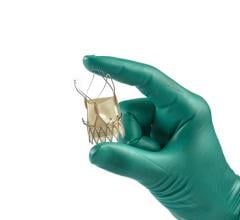March 19, 2014 — Surgeons in France have successfully replaced the aortic valve in two patients without opening the chest during surgery. The procedure, using totally endoscopic aortic valve replacement (TEAVR), shows potential for improving quality of life of heart patients by offering significantly reduced chest trauma. It is described in The Journal of Thoracic and Cardiovascular Surgery.
TEAVR had not been feasible previously because of the currently available designs of stented tissue valves. The recent advent of sutureless bioprostheses mounted on a compressible self-expanding nitinol (nickel titanium) stent, was one of the key factors enabling the surgical team to perform this procedure. Implantation required less than 45 minutes in either patient. Sutureless substitutes are not yet available for the other cardiac valves, like the mitral valve.
“In our institution, we began by adopting the mini-sternotomy technique, involving a small incision through the sternum, as routine. We then transitioned to the right mini-thoracotomy approach, involving a small incision through the thorax, first under direct view, then with an endoscopic camera. Finally we adopted a totally endoscopic technique,” said lead author Marco Vola, M.D., Ph.D, of the Department of Cardiovascular Surgery, Centre Hospitalier Universitaire de Saint-Etienne, France.
“It is important to note that when performing TEAVR, a quick and safe conversion to mini-thoracotomy under direct view can be made if circumstances demand. This would still offer significantly reduced chest trauma,” he said.
In other fields, totally endoscopic surgery involved longer clamping and cardiopulmonary bypass (CPB) times during the learning curve. The investigators believe that clamping and CPB times were acceptable and that the learning curve could be shorter than reported for totally endoscopic coronary artery bypass grafting.
Enhancements such as endoscopic sizers, dedicated instruments for decalcification, and second-generation sutureless bioprostheses to simplify implantation, could improve the procedure further, Vola and his colleagues comment. Last but not least, surgical robots may offer additional benefits.
“These first procedures show that totally endoscopic sutureless aortic valve replacement is technically feasible. Further clinical experience and technical development are necessary to shorten operation times and to assess further the potential postoperative benefits of TEAVR,” said Vola.
For more information: www.jtcvsonline.org


 October 23, 2024
October 23, 2024 








